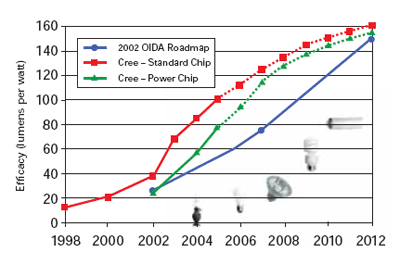Because solid-state lighting is a new technology, it will bring with it a number of new system-level attributes.
These include programmability, small volume, ruggedness and immunity to vibration, compatibility with environmental extremes (cold and heat), and an enhanced efficiency in directed illumination. Ultimately, these system-level attributes are expected to enhance considerably the competitiveness of solid-state lighting relative to traditional incandescent and fluorescent lighting technology.
At this stage, however, it is difficult to assess quantitatively the impact of these system-level attributes, and it is difficult to quantify targets for their evolution. Hence, the SSL-LED Roadmap focuses on lamp-level attributes that are universal to all lighting technologies: luminous efficacy, lifetime, flux/lamp, purchase cost and colorrendering index. A summary of targets for these attributes is shown in Table 1.
| SSL-LED 2002 | SSL-LED 2007 | SSL-LED 2012 | SSL-LED 2020 | Incandesc. | Fluoresc. | |
| Luminous efficacy (lm/W) | 25 | 75 | 150 | 200 | 16 | 85 |
| Lifetime (kh) | 20 | >20 | >100 | >100 | 1 | 10 |
| Flux (lm/lamp) | 25 | 200 | 1,000 | 1,500 | 1,200 | 3,400 |
| Input power (W/lamp) | 1 | 2,7 | 6,7 | 7,5 | 75 | 40 |
| Lumens cost ($/klm) | 200 | 20 | <5 | <2 | 0,4 | 1,5 |
| Lamp cost ($/lamp) | 5 | 4 | <5 | <3 | 0,5 | 5 |
| Colour rendering index (CRI) | 75 | 80 | <80 | <80 | 95 | 75 |
| Lighting markets penetrated | Low flux | Incandescent | Fluorescent | All |
Table 1 : SSL-LED roadmap recommendations (source: OIDA)

Cree roadmap of LED lumens per watt efficacy for standard and power LED chips
Many niche lighting applications which have already begun to penetrate the specific markets are not covered in this roadmap. However, the basic USA science and technology for niche lighting applications are believed to be similar to general lighting, only the high simultaneous risk and reward associated with it are different from that of general white lighting. Hence, in order to meet the lighting targets and lamp targets listed in Table 1, significant challenges must be overcome in a number of areas:
- Substrates, buffers and epitaxy
- Physics, processing and devices
- Lamps, luminaires and systems
These building-block technologies range from fabrication of high-efficiency, low-cost semiconductor materials and epistructures; to the physics, design and processing of highefficiency optoelectronic devices; to the packaging, whitelight conversion, fixturing, and system issues associated with lighting for the 21st century and beyond. We can note that of these areas, lighting systems is the least mature. Lighting systems follow (and are pushed by) the development of the underlying technology; but also they must respond to (and are pulled by) market needs that can be difficult to anticipate. Nevertheless, lighting systems are the ultimate vehicle for implementing solid-state lighting.